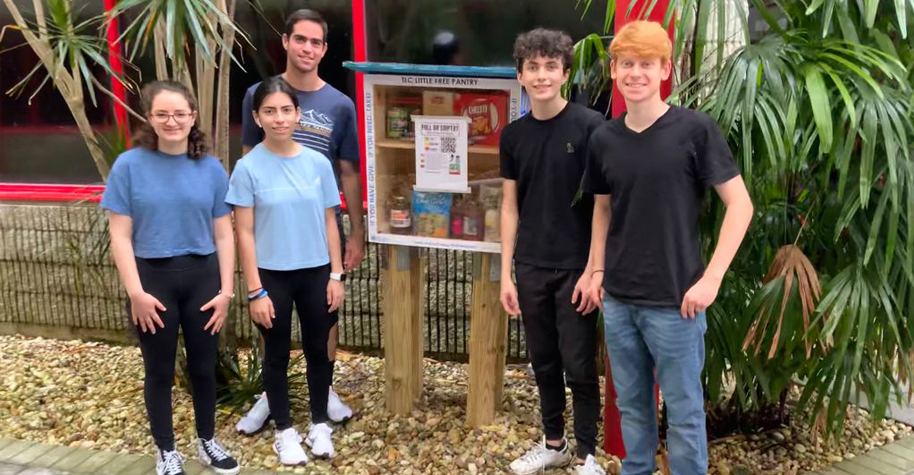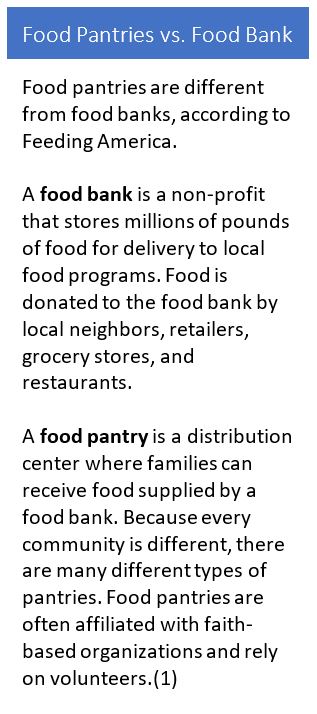Self-Serve Food Pantries Help Feed Local Communities
Posted on by
This student-authored post is published by CPR in partnership with Medill News Service and the Northwestern University Medill School of Journalism, Media, Integrated Marketing Communications. The views and opinions expressed in this article are the author’s own and do not necessarily reflect the views, policies, or positions of CPR or CDC.
Summer Faerman was on a walk in early 2020 when she saw a small wooden box at the entrance of a neighborhood. She investigated.
The box was a free library, where people could take a book for themselves and leave them for others. The idea inspired Faerman to create something similar—a self-serve food pantry.
Faerman started with one pantry in front of a Salvation Army. It was a strategic choice. The Salvation Army is known in the community as a place to donate goods. It’s also a block away from a local elementary school and a public housing development.
Over the past year, one pantry has turned into 52 TLC Little Free Pantries (LFP) located around South Florida. The newest opened last Veteran’s Day in Boca Raton at a mental health center that treats veterans.
LFPs are open 24 hours. There are no questions asked, no judgments passed, and no forms to fill out, explained Faerman.
The pantries are based on the honor system. The words “If you have, give. If you need, take” are posted in multiple languages, including Creole, Portuguese, and Spanish, on the boxes.
People who take from the self-serve food pantries also give, Faerman said. She’s seen people, including members of the local synagogue and passersby, put food in the boxes.
With the pantries being always open, Faerman ran into a problem. When there was just one box, she was able to keep up with demand.
As new pantries opened, it became more difficult for Faerman to keep them stocked. That’s even with the help of volunteers.
In January 2021, Faerman heard from a group of high school students in an engineering club at Donna Klein Jewish Academy with an offer to help. She explained to them her problem of knowing when the pantries were running low. The students suggested creating quick response (QR) codes for the pantries.
QR codes, explains Yair Gritzman, a senior in high school and member of their engineering club, were a simple and inexpensive solution to keeping tabs on the pantries’ inventory.
Gritzman and his schoolmates enlisted the help of their engineering teacher and the Institute for Sensing and Embedded Network Systems Engineering at Florida Atlantic University. Together they launched “Report That Pantry”.
Report That Pantry is a website. QR codes placed on each pantry link to the site, where users of the code can report the level of food inside the pantries to LFP volunteers.
The QR codes, which link to the website, are now being used by self-serve food pantry projects in other states, including Oregon, Louisiana, Oklahoma, and Ohio, to restock their pantries faster.
Faerman said the QR codes make it so that “if there’s one [a pantry] that’s bare, it’s not bare for long.”
People appreciate that they can go at any time and take as much food as they need, said Faerman. Children share how excited, not embarrassed, they are to go to the pantry and pick out food. Thank-you notes are left inside the pantries as well.
Faerman hopes to implement more self-serve pantries soon. For now, she’s focused on keeping the ones they have stocked with food with the help of the website.
Faerman hopes people find inspiration in the TLC LFPs—as she did in the free library—and replicate it in their communities. Building a self-serve pantry is easy and opening an account on “Report That Pantry” is free. People are only limited by their willingness to get involved.
The U.S. Department of Agriculture (USDA) reported in September 2021 that of the 13.8 million food-insecure households in the U.S., 36.5% of them reported using a food pantry in 2020. USDA defines households as food insecure if they have “difficulty providing enough food for all members at some time in the past year because there wasn’t enough money for food.”(2)
Food assistance is available for low-income individuals and communities. Call USDA’s National Hunger Hotline for information on meal sites, food banks, and other services near you. The number is 1-866-3-HUNGRY (1-866-348-6479) or 1-877-8-HAMBRE (1-877-842-6273) for Spanish. The hotline is open Monday through Friday from 7 a.m. to 10 p.m. EST.
Resources
- Public Health Matters: Give & Take Bins Serve as Small-Scale Food Pantries
- Food and Food System Resources
- Healthy People 2023: Food Insecurity
- Supplemental Nutrition Assistance Program
- Emergency Food Assistance Program
References
- https://www.feedingamerica.org/hunger-blog/what-difference-between-food-bank-and-food-pantry
- https://www.ers.usda.gov/topics/food-nutrition-assistance/food-security-in-the-us/key-statistics-graphics.aspx
Thanks in advance for your questions and comments on this Public Health Matters post. Please note that CDC does not give personal medical advice. If you are concerned you have a disease or condition, talk to your doctor.
Have a question for CDC? CDC-INFO (http://www.cdc.gov/cdc-info/index.html) offers live agents by phone and email to help you find the latest, reliable, and science-based health information on more than 750 health topics.
Posted on by

